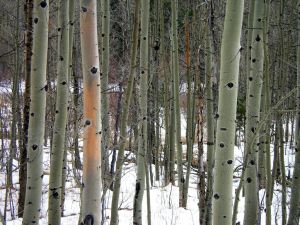Why are some aspens orange or have wet-looking bark?
 Many aspen are turning orange this spring. These orange spots can vary from an almost fluorescent orange color (almost appearing to have been spray-painted) to a deeper, wet, oozing orange-black. In both cases, the cause is a fungus called cytospora canker. Cytospora chrysosperma is generally considered to be a saprophyte or weak parasite, although it can kill trees if the infection gets bad enough, and will spread to other trees, sometimes killing a whole stand. It generally only attacks trees that have been weakened by stresses such as crowding, drought, extreme heat or cold, nutrient imbalance, transplant shock, severe pruning, fire, sunscald injury, frost, insect or mechanical injury, root-feeding nematodes, insect damage, or infection by other pathogenic fungi.
Many aspen are turning orange this spring. These orange spots can vary from an almost fluorescent orange color (almost appearing to have been spray-painted) to a deeper, wet, oozing orange-black. In both cases, the cause is a fungus called cytospora canker. Cytospora chrysosperma is generally considered to be a saprophyte or weak parasite, although it can kill trees if the infection gets bad enough, and will spread to other trees, sometimes killing a whole stand. It generally only attacks trees that have been weakened by stresses such as crowding, drought, extreme heat or cold, nutrient imbalance, transplant shock, severe pruning, fire, sunscald injury, frost, insect or mechanical injury, root-feeding nematodes, insect damage, or infection by other pathogenic fungi.
Cankers first appear as sunken, discoloured zones with raised edges or bright orange patches. The canker’s inner bark progressively changes in colour from bright orange to black and can have a foul odor. After 2 to 3 years, the dead bark falls off the stem in large pieces. Sapwood associated with the canker is stained light to reddish-brown. Elongated cankers with defined borders form on weakened stems. Branches and twigs can be colonized and killed without canker formation.
Pimple-like fruiting bodies, called pycnidia, which exude orange to red-colored spore masses in hairlike coils, can be produced during wet weather after infection. During rains, these spores are partially washed away and can spread into new wounds. Also, as these structures dry, the spores are released and are carried by dripping and splashing rain, wind, insects and birds to other trees. The spores then land on open wounds on larger branches or the trunk (from carving, fire mitigation work, elk, etc.) or on the leaf scars of younger twigs. The fungus becomes established in the dead bark and then grows into living tissue. It spreads through the bark cells and then into the outer rings of the wood. This causes a girdling effect, which restricts water and nutrients needed by the plant. During the winter, the fungus overwinters in the infected tissue of the plants.
Canker diseases are among the primary agents in creating snags and creating infection sites for decay fungi. This can be either good or bad – standing “dead and down” woody material provides biological diversity in stands and serves as habitat for cavity-nesting animals and birds. Endemic levels of infection by these organisms are essential to maintaining a balanced ecosystem and serve an important role in the dynamics and ecology of aspen stands.
However, on valuable trees close to your house, you might consider the canker to be a bad thing. To help prevent spread of the canker, remove all dead and dying branches on affected trees. If cankers are confined to twigs or branches, diseased bark and discolored wood may be removed with a sharp knife by cutting back 1 to 2 inches into surrounding live, healthy tissues. Avoid leaving branch stubs. Do not prune or work around trees when the bark is wet as this helps to spread the fungus. Pruning tools should be sterilized between cuts by swabbing them with 70 percent rubbing alcohol or fresh household liquid bleach (1 part of bleach to 9 parts of water). Remove and burn or bury all affected parts as soon as possible. Severely cankered trees cannot be restored to good health and should be cut down and burned because they are a source of infection for other trees. Stands with a high proportion of cankered stems should be clearcut to stimulate sucker production and regeneration of the stand (and the diseased plants should be hauled, buried, or burned).
For more information:
http://extension.colostate.edu/topic-areas/yard-garden/cytospora-canker-2-937/
https://www.na.fs.fed.us/spfo/pubs/fidls/q_aspen/q_aspen.htm
Search:
Categories
Archives
Additional Resources
Events Calendar
| M | T | W | T | F | S | S |
|---|---|---|---|---|---|---|
| 1 | 2 | 3 | 4 | 5 | ||
| 6 | 7 | 8 | 9 | 10 | 11 | 12 |
| 13 | 14 | 15 | 16 | 17 | 18 | 19 |
| 20 | 21 | 22 | 23 | 24 | 25 | 26 |
| 27 | 28 | 29 | 30 | 31 | ||


